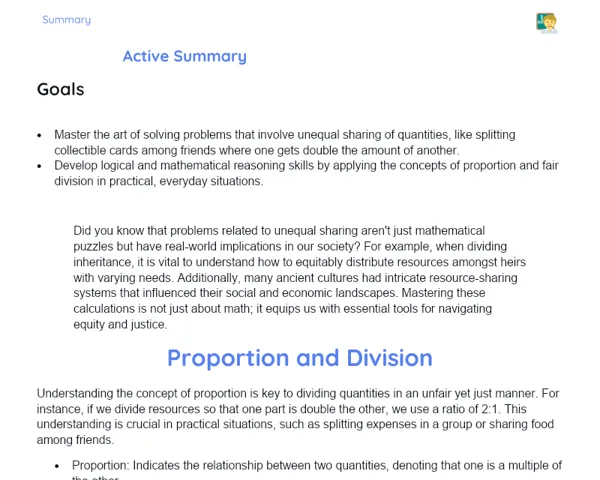Socioemotional Summary Conclusion
Goals
1. Develop the skill to calculate the volume of rectangular prisms.
2. Apply knowledge of volume to real-life situations, like figuring out the volume of bottles and storage compartments.
Contextualization
Picture this: you're looking to rearrange your room and might need to buy some new furniture. To ensure everything fits just right, you need to calculate the volume of both the furniture and the available space. Being skilled at calculating the volumes of rectangular prisms will not only help in this scenario but also in daily situations, like selecting the best water bottle or planning a move to a new house. Let’s learn together how to master this important mathematical skill!
Exercising Your Knowledge
Definition of Volume
Volume refers to the amount of space an object occupies. For a rectangular prism, we find the volume by multiplying its width (W), height (H), and length (L). Grasping the concept of volume and knowing how to calculate it is vital as it applies to many everyday situations, from organizing spaces to planning storage.
-
Volume is the space occupied by an object.
-
To find the volume of rectangular prisms, multiply three dimensions: width, height, and length.
-
Understanding volume helps in organizing spaces, be it for moving houses or selecting a proper gift box.
Formula for the Volume of a Rectangular Prism
The formula for calculating the volume of a rectangular prism is V = W x H x L, where V is the volume, W is the width, H is the height, and L is the length. This straightforward formula allows us to calculate volume quickly once we have the dimensions. It's crucial to understand this formula for efficiently addressing volume-related problems.
-
The formula is: Volume = Width x Height x Length (V = W x H x L).
-
This formula enables us to swiftly find the volume of any rectangular prism, provided we have the right dimensions.
-
Using this formula accurately is fundamental for tackling practical and mathematical challenges involving volume.
Units of Measure
Volume is usually measured in cubic units, like cubic centimeters (cm³), cubic meters (m³), etc. It’s essential to ensure all dimensions are in the same unit before calculating volume to avoid mistakes. Having standardized units is important for accurate calculations and for clearly communicating results.
-
Volume is represented in cubic units, such as cm³, m³, etc.
-
Make sure all dimensions are in the same unit before starting the volume calculation.
-
Standardizing measurement units guarantees precision in calculations and clear communication of results.
Key Terms
-
Volume: The space occupied by an object.
-
Rectangular Prism: A three-dimensional shape with rectangular faces.
-
Cubic Units: Units for measuring volume, like cm³ and m³.
-
Width (W): The horizontal dimension of an object.
-
Height (H): The vertical dimension of an object.
-
Length (L): The lengthwise dimension of an object.
For Reflection
-
How can you use your understanding of the volumes of rectangular prisms in your day-to-day life?
-
In what ways does knowing how to calculate volumes aid you in making thoughtful and responsible decisions?
-
What strategies did you use to handle potential frustrations or difficulties during the lesson?
Important Conclusions
-
Understanding and calculating the volume of rectangular prisms is a crucial skill with numerous practical applications in our daily lives.
-
Being able to calculate volumes helps in making informed choices, whether in organizing spaces or selecting appropriate packaging.
-
This lesson highlighted the importance of applied mathematics, marrying theoretical knowledge with practical situations, while also fostering valuable socio-emotional skills.
Impacts on Society
Students' understanding of volumes greatly affects their lives as it empowers them to manage their surrounding spaces better, whether it’s organizing their rooms or planning moves. Moreover, the skill of calculating volumes allows for more sustainable choices, such as selecting packaging that minimizes waste while maximizing space usage.
Emotionally, grasping and applying volume calculations can bolster students' confidence in everyday tasks, enhancing their problem-solving abilities and responsible decision-making. This learning process also nurtures essential skills like teamwork and conflict resolution, since collaborating on volume measurements encourages effective communication and cooperation.
Dealing with Emotions
To manage your emotions while delving into this topic, try a brief reflection based on the RULER method. First, recognize how you feel as you work with volume calculations—are you feeling confident, anxious, frustrated, or excited? Next, identify what’s causing those emotions: what’s prompting these feelings? Then, articulate your emotions using specific words such as 'confidence', 'anxiety', or 'frustration'. Finally, consider how you can express and regulate those feelings constructively. For instance, if frustration arises, take a deep breath or ask a peer for assistance. Regular practice of this exercise will enhance your emotional self-regulation skills.
Study Tips
-
Practice calculating volumes using everyday items. Measure various boxes, books, or bottles, and apply the formula V = W x H x L.
-
Maintain a study journal to log the volumes you calculate, reflecting on the strategies used and the emotions encountered during the process.
-
Form study groups with classmates to exchange experiences and tackle challenges together, helping each other refine measurement accuracy and understanding of volume.



